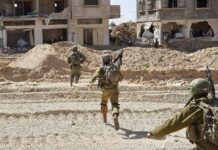 Jonathan Cheng of The Wall Street Journal reports:
Jonathan Cheng of The Wall Street Journal reports:
Hong Kong’s three billionaire Kwok brothers have just the answer for the rising waters threatening the global economy: the world’s first life-size replica of Noah’s ark, built to biblical specifications off the coast of this recession-struck Chinese financial center.
The message in its 450-foot-long hull, its rooftop luxury hotel and 67 pairs of fiberglass animals: “The financial tsunami will be over,” says Spencer Lu, the Kwoks’ project director at Noah’s Ark, which is opening soon.The land-bound ark wasn’t built in response to the current global turmoil; it has been in the planning for 17 years. But the financial storm provides a nice marketing hook for the Kwoks’ ambitious project, which will probably need to lure visitors from beyond Hong Kong’s city limits to be an economic success.
It also ups the ante in the competition to build a big ark. Middle brother and ark champion Thomas Kwok insisted that it be constructed according to biblical specs, in part to distinguish it from one in the Netherlands that actually floats and boasts real farm animals but is just one-fifth the size of the biblical original.
Minders of the Dutch ark say they were in touch with the Hong Kong team and don’t see it as competition. “We stand for the same goal as far as I can tell,” said Jacky Baken, a 35-year-old gardener who quit her business to work full time on the ark. She says the group is at work on a full-size water-going version. And, she says, “We’re still the first one with the floating ark.”
These are just the latest additions to a veritable ark armada built around the world by the devout and the merely driven — from a 300-foot-long ark built by a pastor in the Canadian town of Florenceville, New Brunswick, to one built by Greenpeace in 2007 on Turkey’s Mount Ararat, warning of “impending climate disaster.”
Richard Greene, a 72-year-old evangelical minister, began building his full-size ark, in Frostburg, Md., after a vision he says came to him in 1974. Mr. Greene ran out of funds in the 1990s, leaving a giant skeleton of concrete and steel, but he says that 35 years on, he hasn’t lost hope, though he can’t help but be in awe of the other ark-builders. “If I got jealous of what other people are doing, this whole thing would have sunk years ago,” he says. “You just keep on keeping on…But if God doesn’t move a lot quicker, I won’t be around to see the completion of this ark.”
Some latter-day Noahs believe the biblical story of a flood washing away man’s misdeeds resonates in a time of sunken financial institutions and economic tumult. “Things aren’t going so well, and God, even in the midst of all that trouble, has provided an ark of safety, a place where people can turn into and go,” says Nathan Smith, a pastor at the Florenceville church.
“People are scared and they don’t know where they’re going,” says Johan Huibers, the 50-year-old builder of the Dutch ark, who hopes to be able to sail the boat to London in time for the 2012 Olympics, and then on to the U.S. and Australia.
The Dutch version is made up of iron barges under the wood, while the Hong Kong ark is made of concrete reinforced with glass fiber.
Hong Kong’s ark builders also tried to install a permanent rainbow through light refraction but eventually gave up when the science proved too difficult. The Dutch team is also wrestling with the challenge of installing a convincing rainbow.
The Kwok brothers, backers of the Hong Kong ark, are heirs to their father’s blue-chip Sun Hung Kai Properties Ltd., which at the height of the real-estate boom was the world’s largest property developer by market capitalization. But the brothers squabbled in recent years, and last year the board voted to oust eldest brother Walter Kwok as chairman and installed their 80-year-old mother to succeed him.
The Kwoks’ version of the ark, which sits on 270,000 square feet of space and was developed in conjunction with five organizations, houses a restaurant, exhibition hall and children’s museum in addition to the Noah’s Resort hotel. Mr. Kwok won’t disclose the cost of the project, which is beached on a small island in Hong Kong’s harbor most reachable via ferry, at the foot of a busy bridge that connects the city to its airport.
Mr. Lu says his team has yet to come up with a strategy for promoting it to mainland Chinese, many of whom aren’t familiar with the tale. The company is touting the project as a family-friendly vacation spot, and is framing it as an answer to the economic woes felt around the globe.
“People are experiencing a crisis right now,” says Mr. Lu, waving his hand over fiberglass statues of a pair of bears overlooking the South China Sea. “It’s possible that this financial tsunami has come at this time to Hong Kong for a reason. And our message is: The doors of the ark are not closed, they’re open, and the animals — representing new life — are coming out.”
The project has also come under fire from some groups that say the government shouldn’t have granted Mr. Kwok a 21-year lease on the island to build an explicitly religious project, without the approval of the legislature. Mr. Lu says the park isn’t promoting religion. “We’re promoting meaning,” he says.
Frances Leung, a 57-year-old social worker who has seen a big chunk of her savings evaporate in the markets, was invited to visit the ark before its official opening. She says she drew great inspiration from seeing the animals, and new hope.
“When you go to Disneyland, there’s really no message there,” says Ms. Leung. “But at Noah’s Ark, there is such a strong message that life goes on.”
{The Wall Street Journal/Matzav.com Newscenter}












Ok
chazzon ish or rav chaim naah